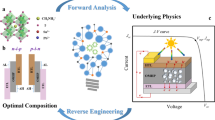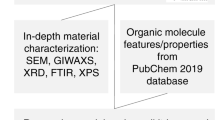Abstract
Perovskite solar cells have drawn extensive attention in the photovoltaic (PV) field due to their rapidly increasing efficiency. Recently, additives have become necessary for the fabrication of highly efficient perovskite solar cells (PSCs). Additionally, alkali metal doping has been an effective method to decrease the defect density in the perovskite film. However, the traditional trial-and-error method to find the optimal doping concentration is time-consuming and needs a significant amount of raw materials. In this work, in order to explore new ways of facilitating the process of finding the optimal doping concentration in perovskite solar cells, we applied a machine learning (ML) approach to assist the optimization of KI doping in MAPbI3 solar cells. With the aid of ML technique, we quickly found that 3% KI doping could further improve the efficiency of MAPbI3 solar cells. As a result, a highest efficiency of 20.91% has been obtained for MAPbI3 solar cells.










Similar content being viewed by others
References
Park NG. Organometal perovskite light absorbers toward a 20% efficiency low-cost solid-state mesoscopic solar cell. J Phys Chem Lett. 2013;4(15):2423.
Xiao ZG, Bi C, Shao YC, Dong QF, Wang Q, Yuan YB, Wang CG, Gao YL, Huang JS. Efficient, high yield perovskite photovoltaic devices grown by interdiffusion of solution-processed precursor stacking layers. Energy Environ Sci. 2014;7(8):2619.
Zhumekenov AA, Saidaminov MI, Haque MA, Alarousu E, Sarmah SP, Murali B, Dursun I, Miao XH, Abdelhady AL, Wu T, Mohammed OF, Bakr OM. Formamidinium lead halide perovskite crystals with unprecedented long carrier dynamics and diffusion length. ACS Energy Lett. 2016;1(1):32.
Stranks SD, Eperon GE, Grancini G, Menelaou C, Alcocer MJP, Leijtens T, Herz LM, Petrozza A, Snaith HJ. Electron–hole diffusion lengths exceeding 1 micrometer in an organometal trihalide perovskite absorber. Science. 2013;342(6156):341.
Ju DX, Dang YY, Zhu ZL, Liu HB, Chueh CC, Li XS, Wang L, Hu XB, Jen AKY, Tao XT. Tunable band gap and long carrier recombination lifetime of stable mixed CH3NH3PbxSn1-xBr3 single crystals. Chem Mater. 2018;30(5):1556.
Filip MR, Eperon GE, Snaith HJ, Giustino F. Steric engineering of metal-halide perovskites with tunable optical band gaps. Nat Commun. 2014;5:5757.
Kojima A, Teshima K, Shirai Y, Miyasaka T. Organometal halide perovskites as visible-light sensitizers for photovoltaic cells. J Am Chem Soc. 2009;131(17):6050.
Jiang Q, Zhao Y, Zhang XW, Yang XL, Chen Y, Chu ZM, Ye QF, Li XX, Yin ZG, You JB. Surface passivation of perovskite film for efficient solar cells. Nat Photonics. 2019;13(7):460.
Wu CC, Wang D, Zhang YQ, Gu FD, Liu CH, Zhu N, Luo W, Han D, Guo X, Qu B, Wang SF, Bian ZQ, Chen ZJ, Xiao LX. FAPbI(3) flexible solar cells with a record efficiency of 19.38% fabricated in air via ligand and additive synergetic process. Adv Funct Mater. 2019;29(34):1902974.
Cui P, Wei D, Ji J, Huang H, Jia ED, Dou SY, Wang TY, Wang WJ, Li MC. Planar p-n homojunction perovskite solar cells with efficiency exceeding 21.3%. Nat Energy. 2019;4(2):150.
Wang LG, Zhou HP, Hu JN, Huang BL, Sun MZ, Dong BW, Zheng GHJ, Huang Y, Chen YH, Li L, Xu ZQ, Li NX, Liu Z, Chen Q, Sun LD, Yan CH. A Eu3+-Eu2+ ion redox shuttle imparts operational durability to Pb-I perovskite solar cells. Science. 2019;363(6424):265.
Chen BX, Rao HS, Li WG, Xu YF, Chen HY, Kuang DB, Su CY. Achieving high-performance planar perovskite solar cell with Nb-doped TiO2 compact layer by enhanced electron injection and efficient charge extraction. J Mater Chem A. 2016;4(15):5647.
Zhang HY, Shi JJ, Xu X, Zhu LF, Luo YH, Li DM, Meng QB. Mg-doped TiO2 boosts the efficiency of planar perovskite solar cells to exceed 19%. J Mater Chem A. 2016;4(40):15383.
Noh YW, Lee JH, Jin IS, Park SH, Jung JW. Tailored electronic properties of Zr-doped SnO2 nanoparticles for efficient planar perovskite solar cells with marginal hysteresis. Nano Energy. 2019;65:104014.
Mao GP, Wang W, Shao S, Sun XJ, Chen SA, Li MH, Li HM. Research progress in electron transport layer in perovskite solar cells. Rare Met. 2018;37(2):95.
Burschka J, Pellet N, Moon SJ, Humphry-Baker R, Gao P, Nazeeruddin MK, Gratzel M. Sequential deposition as a route to high-performance perovskite-sensitized solar cells. Nature. 2013;499(7458):7458.
Jung JW, Chueh CC, Jen AKY. A low-temperature, solution-Processable, Cu-doped nickel oxide hole-transporting layer via the combustion method for high-performance thin-film perovskite solar cells. Adv Mater. 2015;27(47):7874.
Li Z, Tinkham J, Schulz P, Yang MJ, Kim DH, Berry J, Sellinger A, Zhu K. Acid additives enhancing the conductivity of spiro-OMeTAD toward high-efficiency and hysteresis-less planar perovskite solar cells. Adv Energy Mater. 2017;7(4):1601451.
Li MH, Hsu CW, Shen PS, Cheng HM, Chi Y, Chen P, Guo TF. Novel spiro-based hole transporting materials for efficient perovskite solar cells. Chem Commun. 2015;51(85):15518.
Jain A, Ong SP, Hautier G, Chen W, Richards WD, Dacek S, Cholia S, Gunter D, Skinner D, Ceder G, Persson KA. Commentary: The Materials Project: a materials genome approach to accelerating materials innovation. APL Mater. 2013;1(1):011002.
Takahashi K, Tanaka Y. Materials informatics: a journey towards material design and synthesis. Dalton Trans. 2016;45(26):10497.
Agrawal A, Choudhary A. Perspective: Materials informatics and big data: realization of the "fourth paradigm" of science in materials science. APL Mater. 2016;4(5):053208.
Ramprasad R, Batra R, Pilania G, Mannodi-Kanakkithodi A, Kim C. Machine learning in materials informatics: recent applications and prospects. NPJ Comput Mater. 2017;3:54.
Wu HH, Zhu JM, Zhang TY. Pseudo-first-order phase transition for ultrahigh positive/negative electrocaloric effects in perovskite ferroelectrics. Nano Energy. 2015;16:419.
Wu HH, Cohen RE. Electric-field-induced phase transition and electrocaloric effect in PMN-PT. Phys Rev B. 2017;96(5):054116.
Wu HH, Meng Q, Huang H, Liu CT, Wang XL. Tuning the indirect-direct band gap transition in the MoS2-xSex armchair nanotube by diameter modulation. Phys Chem Chem Phys. 2018;20(5):3608.
Li F, Peng X, Wang Z, Zhou Y, Wu Y, Jiang M, Xu M. Machine learning (ML)-assisted design and fabrication for solar cells. Energy Environ Mater. 2019;2(4):280.
Pilania G, Balachandran PV, Kim C, Lookman T. Finding new perovskite halides via machine learning. Front Mater. 2016;3:19.
Agiorgousis ML, Sun YY, Choe DH, West D, Zhang SB. Machine learning augmented discovery of chalcogenide double perovskites for photovoltaics. Adv Theory Simul. 2019;2(5):1800173.
Li W, Jacobs R, Morgan D. Predicting the thermodynamic stability of perovskite oxides using machine learning models. Comput Mater Sci. 2018;150:454.
Halder A, Ghosh A, Dasgupta TS. Machine-learning-assisted prediction of magnetic double perovskites. Phys Rev Mater. 2019;3(8):084418.
Takahashi K, Takahashi L, Miyazato I, Tanaka Y. Searching for hidden perovskite materials for photovoltaic systems by combining data science and first principle calculations. ACS Photonics. 2018;5(3):771.
Li XL, Hou ZF, Gao SS, Zeng Y, Ao JP, Zhou ZQ, Da B, Liu W, Sun Y, Zhang Y. Efficient optimization of the performance of Mn2+-doped kesterite solar cell: machine learning aided synthesis of high efficient Cu2(Mn, Zn)Sn(S, Se)4 solar cells solar cells. Solar RRL. 2018;2(12):1800198.
Zhao WG, Yao Z, Yu FY, Yang D, Liu SZ. Alkali metal doping for improved CH3NH3PbI3 perovskite solar cells. Adv Sci. 2018;5(2):1700131.
Zhao P, Yin W, Kim M, Han M, Song YJ, Ahn TK, Jung HS. Improved carriers injection capacity in perovskite solar cells by introducing A-site interstitial defects. J Mater Chem A. 2017;5(17):7905.
Son DY, Kim SG, Seo JY, Lee SH, Shin H, Lee D, Park NG. Universal approach toward hysteresis-free perovskite solar cell via defect engineering. J Am Chem Soc. 2018;140(4):1358.
Choi H, Jeong J, Kim HB, Kim S, Walker B, Kim GH, Kim JY. Cesium-doped methylammonium lead iodide perovskite light absorber for hybrid solar cells. Nano Energy. 2014;7:80.
Saliba M, Matsui T, Domanski K, Seo JY, Ummadisingu A, Zakeeruddin SM, Correa-Baena JP, Tress WR, Abate A, Hagfeldt A, Gratzel M. Incorporation of rubidium cations into perovskite solar cells improves photovoltaic performance. Science. 2016;354(6309):206.
Zhao WG, Yang D, Liu SF. Organic-inorganic hybrid perovskite with controlled dopant modification and application in photovoltaic device. Small. 2017;13(25):1604153.
Zhu N, Qi X, Zhang YQ, Liu GH, Wu CC, Wang D, Guo X, Luo W, Li XD, Hu HZ, Chen ZJ, Xiao LX, Qu B. High efficiency (18.53%) of flexible perovskite solar cells via the insertion of potassium chloride between SnO2 and CH3NH3PbI3 layers. ACS Appl Energy Mater. 2019;2(5):3676.
Abdi-Jalebi M, Andaji-Garmaroudi Z, Cacovich S, Stavrakas C, Philippe B, Richter JM, Alsari M, Booker EP, Hutter EM, Pearson AJ, Lilliu S, Savenije TJ, Rensmo H, Divitini G, Ducati C, Friend RH, Stranks SD. Maximizing and stabilizing luminescence from halide perovskites with potassium passivation. Nature. 2018;555(7697):497.
Li X, Bi DQ, Yi CY, Decoppet JD, Luo JS, Zakeeruddin SM, Hagfeldt A, Gratzel M. A vacuum flash-assisted solution process for high-efficiency large-area perovskite solar cells. Science. 2016;353(6294):58.
Williams CK, Rasmussen CE. Gaussian Processes for Machine Learning, Vol. 63. Cambridge: MIT Press; 2006. 3176.
Im JH, Jang IH, Pellet N, Gratzel M, Park NG. Growth of CH3NH3PbI3 cuboids with controlled size for high-efficiency perovskite solar cells. Nat Nanotechnol. 2014;9(11):927.
Nie WY, Tsai HH, Asadpour R, Blancon JC, Neukirch AJ, Gupta G, Crochet JJ, Chhowalla M, Tretiak S, Alam MA, Wang HL, Mohite AD. High-efficiency solution-processed perovskite solar cells with millimeter-scale grains. Science. 2015;347(6221):522.
Kong DH, Park NG. On the current-voltage hysteresis in perovskite solar cells: dependence on perovskite composition and methods to remove hysteresis. Adv Mater. 2019;31(34):1805214.
Kuai L, Wang YS, Zhang ZX, Yang YG, Qin YS, Wu T, Li YJ, Li YY, Song T, Gao XY, Wang L, Sun BQ. Passivating crystal boundaries with potassium-rich phase in organic halide perovskite. Solar RRL. 2019;3(5):1900053.
Leupold N, Schotz K, Cacovich S, Bauer I, Schultz M, Daubinger M, Kaiser L, Rebai A, Rousset J, Kohler A, Schulz P, Moos R, Panzer F. High versatility and stability of mechanochemically synthesized halide perovskite powders for optoelectronic devices. ACS Appl Mater Interfaces. 2019;11(33):30259.
Liu ZH, Hu JN, Jiao HY, Li L, Zheng GHJ, Chen YH, Huang Y, Zhang Q, Shen C, Chen Q, Zhou HP. Chemical reduction of intrinsic defects in thicker heterojunction planar perovskite solar cells. Adv Mater. 2017;29(23):1606774.
Acknowledgements
This work was financially supported by Nanchang University High Talent Project (No. 9166-2701010119), the National Key R&D Program of China (No. 2016YFB0401003) and the National Natural Science Foundation of China (Nos.61935016, 61775004 and U1605244).
Author information
Authors and Affiliations
Corresponding authors
Rights and permissions
About this article
Cite this article
Jiang, S., Wu, CC., Li, F. et al. Machine learning (ML)-assisted optimization doping of KI in MAPbI3 solar cells. Rare Met. 40, 1698–1707 (2021). https://doi.org/10.1007/s12598-020-01579-y
Received:
Revised:
Accepted:
Published:
Issue Date:
DOI: https://doi.org/10.1007/s12598-020-01579-y




